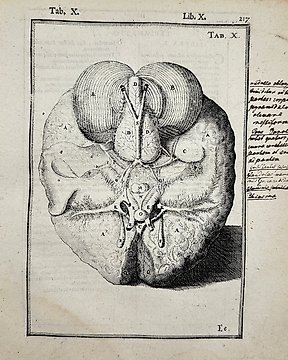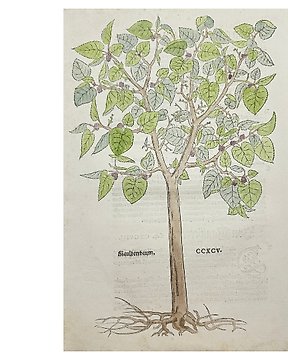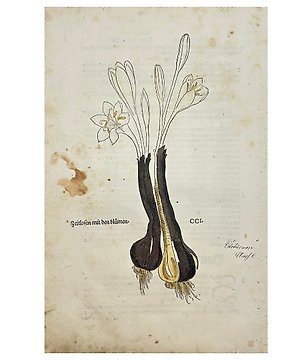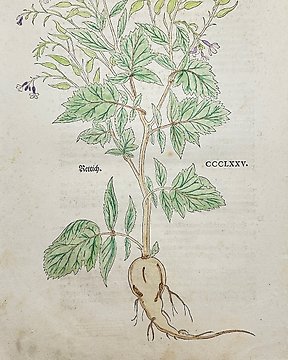Wonderful item perfectly described
Se oversættelseMarco Antonio Sabellicus - Rapsodiae historiarum enneadum - 1535
Nr. 85336331



Marco Antonio SABELLICO (Marcantonio COCCIO) (1436 C. -1506)
Rapsodiae historiarum Enneadum Marci Antonii Cocci Sabellici Ab orde condito Pars prima quinque complectens Enneades: Praemissis earundem Repertoriis & Epitomis. Vaenunt 1535 Lugduni. in aedibus Iacobi Giunti bibliopolae (Colophon: Excudebant Nicolaus Paruus & Hector Penet co[n]sortes Lugduni 1535) / Posterior pars Eiusdem Rapsodiae historiarum Marcii Antonii Cocci Sabellici ab orbe condito, co[n]tinens sex Enneades reliquas, cum earundem Repertoriis & Epitomis 1535, Vaenundantur ubi & reliqua pars ab Iacobi Giunti bibliopola (Colophon: recepit finem Lugduni in aedibus Nicolai Petit & Hector Penet consortium, 1535).
§ 2 parts in 2 volumes, folio (320x215); [26] leaves, 506 pp. [1] blank leaf, signature: a, e, i6, o8, a-z6, A-Z6, Aa-Dd6, Ee4 (some pp. misnumbered). [16] leaves, 562 pp., [1] blank leaf, signature: aa6, ee4, ii6, aa-zz6, AA-ZZ6, AAA6. Printer’s mark of Giacomo Giunti on both title pages. Text on 2 columns, Roman fonts; title pages printed in red and black, within woodcut frame. Woodcut initials. Contemporary vellum, handwritten title and gilt title-pieces on spine. Ancient ownership signature on both title pages:, spine a little restored. Fine copy on crisp paper, the entire two-volumes set, complete under all respects.
Rare and fascinating edition shared by the printers Petit and Penet and the editors Giacomo Francesco Giunta and Vincent de Portinariis. There are two variants known of the both parts, with the device of Vincent de Portonariis or of Giacomo Giunta, respectively, according to Renouard, while Baudrier V, p. 456) cites copies with the name and device of Nicolas Petit and Hector Penet, printers. This edition is a reprint of the 1527-1528 one (Paris, Badius), without Badius’ preface, but with his Explanatio and his index, were his name has been suppressed.
The work, a universal history from the origins of the world up to the author's times, was started perhaps around 1491 and in 1498 the sixty-three books (seven "enneads", which replaced the more usual “decades”) were completed, covering the time until the sacking of Rome by the Visigoths in 1410, and it was published in Venice. The second part, including the subsequent history up to 1503, was published in 1504. The work, thanks to its encyclopedic nature and to the succinct nature of the treatment, obtained a considerable editorial fortune. The last part, dealing with contemporary topics events, is especially interesting because of some digressions related to the use of the vernacular in Italy in a premise to the eleventh ennead, showing the attention paid by Sabellico (who wrote exclusively in Latin), to the problem of the vernacular, in the typical perspective that will lead to the theorization of the courtesan language, against the claimed Tuscan superiority, just as in De Latinae linguae reparatione he had denounced the vulgar yielding of the Florentine humanism (Tateo). The author, Marcantonio Coccio, he took the name of “Sabellico” from his birthplace, Vicovaro in Sabina (Lazio); a scholar and historian, he was a pupil of Pomponius Mela and wrote several works, of which the present one is the most famous.
FRANCESCO TATEO Coccio, Marcantonio, detto Marcantonio Sabellico In: Dizionario Biografico degli Italiani; PHILIPPE RENOUARD, Josse Badius Ascensius, III p. 226-227 (erroneously gives 606 pp. for the first volume); BAUDRIER, V, pp. 455-456; BAUDRIER, VI, pp. 166-167.
Marco Antonio SABELLICO (Marcantonio COCCIO) (1436 C. -1506)
Rapsodiae historiarum Enneadum Marci Antonii Cocci Sabellici Ab orde condito Pars prima quinque complectens Enneades: Praemissis earundem Repertoriis & Epitomis. Vaenunt 1535 Lugduni. in aedibus Iacobi Giunti bibliopolae (Colophon: Excudebant Nicolaus Paruus & Hector Penet co[n]sortes Lugduni 1535) / Posterior pars Eiusdem Rapsodiae historiarum Marcii Antonii Cocci Sabellici ab orbe condito, co[n]tinens sex Enneades reliquas, cum earundem Repertoriis & Epitomis 1535, Vaenundantur ubi & reliqua pars ab Iacobi Giunti bibliopola (Colophon: recepit finem Lugduni in aedibus Nicolai Petit & Hector Penet consortium, 1535).
§ 2 parts in 2 volumes, folio (320x215); [26] leaves, 506 pp. [1] blank leaf, signature: a, e, i6, o8, a-z6, A-Z6, Aa-Dd6, Ee4 (some pp. misnumbered). [16] leaves, 562 pp., [1] blank leaf, signature: aa6, ee4, ii6, aa-zz6, AA-ZZ6, AAA6. Printer’s mark of Giacomo Giunti on both title pages. Text on 2 columns, Roman fonts; title pages printed in red and black, within woodcut frame. Woodcut initials. Contemporary vellum, handwritten title and gilt title-pieces on spine. Ancient ownership signature on both title pages:, spine a little restored. Fine copy on crisp paper, the entire two-volumes set, complete under all respects.
Rare and fascinating edition shared by the printers Petit and Penet and the editors Giacomo Francesco Giunta and Vincent de Portinariis. There are two variants known of the both parts, with the device of Vincent de Portonariis or of Giacomo Giunta, respectively, according to Renouard, while Baudrier V, p. 456) cites copies with the name and device of Nicolas Petit and Hector Penet, printers. This edition is a reprint of the 1527-1528 one (Paris, Badius), without Badius’ preface, but with his Explanatio and his index, were his name has been suppressed.
The work, a universal history from the origins of the world up to the author's times, was started perhaps around 1491 and in 1498 the sixty-three books (seven "enneads", which replaced the more usual “decades”) were completed, covering the time until the sacking of Rome by the Visigoths in 1410, and it was published in Venice. The second part, including the subsequent history up to 1503, was published in 1504. The work, thanks to its encyclopedic nature and to the succinct nature of the treatment, obtained a considerable editorial fortune. The last part, dealing with contemporary topics events, is especially interesting because of some digressions related to the use of the vernacular in Italy in a premise to the eleventh ennead, showing the attention paid by Sabellico (who wrote exclusively in Latin), to the problem of the vernacular, in the typical perspective that will lead to the theorization of the courtesan language, against the claimed Tuscan superiority, just as in De Latinae linguae reparatione he had denounced the vulgar yielding of the Florentine humanism (Tateo). The author, Marcantonio Coccio, he took the name of “Sabellico” from his birthplace, Vicovaro in Sabina (Lazio); a scholar and historian, he was a pupil of Pomponius Mela and wrote several works, of which the present one is the most famous.
FRANCESCO TATEO Coccio, Marcantonio, detto Marcantonio Sabellico In: Dizionario Biografico degli Italiani; PHILIPPE RENOUARD, Josse Badius Ascensius, III p. 226-227 (erroneously gives 606 pp. for the first volume); BAUDRIER, V, pp. 455-456; BAUDRIER, VI, pp. 166-167.
- 4
- 1
- 0
Very citified
Se oversættelseTutto bene, grazie.
Se oversættelseNão era precisa, nem completa, a descrição feita.
Se oversættelsePerfetto
Se oversættelse








